Khabar Magazine. October 2023 print cover story.
If the first thing you do when you wake up in the morning is reach out for a cup of tea and biscuits, if you reminisce about having friendly banter with college friends by a tea stall on a street corner, if you crave hot masala tea and crispy pakora each time there is heavy rainfall, if you feel that a refreshing cup of chai wipes away your tiredness after a long journey, if the rising steam from the hot liquid on a cold winter day is blissful… then you understand why chai—the full- bodied, strong-colored concoction simmered in spices, milk and sugar—is no ordinary beverage. It sets the rhythm of a household, captures the vibe of a busy train station, and bonds people over official and social gatherings. Chai is synonymous with India.
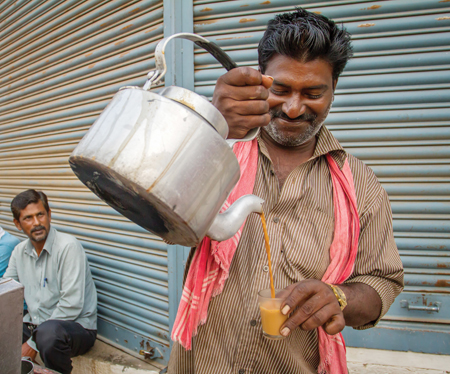
So how did this drink come to be and manage to penetrate every aspect of our lives, not only back home, but even within Western society?
While the discovery of tea dates back over 5,000 years to China, there are many theories for how chai came to be. In ancient India, chai was kadha—a healing drink of herbs and spices that was used for medicinal purposes. While ancient Ayurveda knowledge prevailed, nutritionists today concur that ginger and black pepper provide warmth and aid digestion, cloves have antiseptic properties, cardamom lifts moods, cinnamon supports circulation and respiratory function, and star anise is a natural mouth freshener.

The Singhpo tribe in Northeast India had been using tea leaves as medicine since the 12th century and introduced it to British colonials when they occupied India. In the early 19th century, the British East Indian Company pushed for establishing lucrative tea plantations leading to a tea-drinking nation. Global depression in the 1900s slowed exports and Indians started consuming the abundantly available, affordable, and indulgent beverage themselves. The Indian Tea Association encouraged factories, mines, and textile mills to provide tea breaks to their workers. This is when tea stalls also popped up across Indian cities.
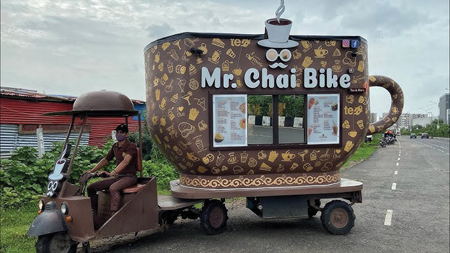
The British introduced their style of drinking tea with milk and sugar. Tea historians suggest that traders and travelers who came from high-quality-milk-producing regions of Maharashtra, Gujarat, and West Bengal may have added milk to tea to create the first form of chai. Cinnamon-ginger-cardamom-flavored chai version evolved with palates. The simple cup of tea became a creamier beverage that was balanced with sweet and spicy flavors to invoke all the senses.
Today, India is the world’s second-largest tea producer, with over 70 percent of its tea consumed domestically. It’s common to see chaiwallas or streetside vendors constantly boiling tea leaves in large clay pots or stainless-steel containers, serving strong “cutting chai” (“half portions”) in small glasses to caffeine addicts throughout the day. But now, you can find modern sit-down tea cafés like Wagh Bakri Tea Lounge, Chai Point, Chai Sutta Bar, Chai Kings, Tea Post, and Chai Thela—India’s answers to Starbucks.
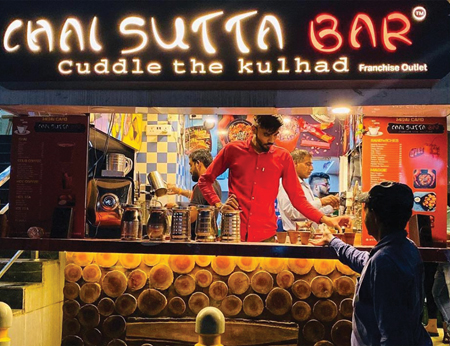

How did chai find its way into American cafe?
Chai was first introduced in the U.S. in the late 1940s but it was Starbucks that popularized it as “chai tea” (which translates to “tea tea”) in the 1990s. Chai tea lattes are usually a mix of milk and a concentrate of spices such as turmeric, cinnamon, fennel seeds, cloves, ginger, star anise, sugar, honey, and vanilla. Today, you can find some form of chai-based drinks—such as chai lattes, dirty chai (with a shot of espresso), mocha chai lattes, vanilla- and pumpkin-flavored chai lattes, and cinnamon-spiced and masala chai drinks—at most specialty coffee shop menus nationwide.
The increasing demand for the exotic, along with chai’s perception as a healthier drink, have combined for it to have more mature and adventurous patrons from all over the world. It is no surprise that American Millennials and Gen Zs are now choosing to drink more tea-based beverages made with vegan, non-dairy, and nut milk. Mainstream grocery stores also carry pre-made chai concentrates, extracts, chai spices, powders, and tea bags, most of which are made by non-Indian brands. Chai spices are creatively used even in baking muffins, cookies, pies, and ice cream recipes.
Surprisingly, the modern American chaiwallas are actually “wallis”—a bunch of women-founded small-batch sustainable tea companies that are often based on fair trade principles. Inspired by their own upbringing and family recipes, these are some of the women in the U.S. who are striving to retain the authenticity of the tea leaf while ensuring that those who work in the industry are also taken care of.
Some of these exemplary women share their personal stories along with their favorite chai recipes.
Madura Chaudhari
Founder and CEO, The Chai Bar
Madura Chaudhari left her data analysis career to fully dedicate herself to chai. In 2017, the Johns Creek resident started The Chai Bar as a premium, single-origin tea company offering an authentic farm-to-cup tea experience that reflects her Indian heritage. The company meticulously sources high-quality tea leaves from South Asia which are sold packaged in beautifully designed tins adorned with Warli folk art and Sanskrit names.
At my home in the Konkan region of India, we always offered chai to guests visiting our home. I started assisting my aai (mother) with making chai when I was around seven or eight years old. My true appreciation for chai blossomed in high school when I enjoyed it with salty parathas before those early 5:30 am classes… and during my college years, I developed a profound connection with chai, especially the ginger-cardamom chai in my dorm’s cafeteria. When I was away from my family, chai became a comforting reminder of home.
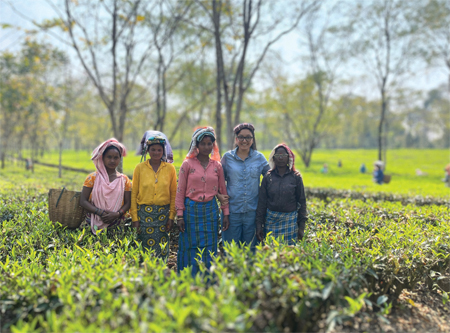
In the quest for the perfect masala chai, the choice of tea leaves, specifically CTC (Cut, Tear, Curl), is undeniably crucial. Among the various grades of black tea leaves available, CTC tea leaves, characterized by their small, ball-like appearance, stand out as the ideal choice for brewing that piping hot, flavorful cup of goodness. CTC tea leaves bring a robust and bold flavor profile to chai.
It’s worth noting that tea leaves can vary significantly between different tea estates and regions.
Each estate imparts its unique flavor and character to the tea. For instance, Assam CTC tea is celebrated for its malty, brisk, and invigorating quality, making it a perfect foundation for a bold masala chai. On the other hand, Darjeeling tea, with its delicate floral notes, creates a lighter and more nuanced version of masala chai.
I personally visit the farms we partner with to audit the harvesting, processing, and packaging. This on-the-ground approach allows me to interact with the workers, ensuring their well-being as well as the quality of our teas. Our commitment to quality is woven into every step of our tea-making journey, from the plantations to your table.
Our top-secret, proprietary masala chai recipe is guarded more closely than the crown jewels! But here’s a little something to tickle your taste buds—our “notso- secret” masala chai recipe that you can tweak to your heart’s content. Feel free to get creative—masala chai is a forgiving canvas for your taste adventures.
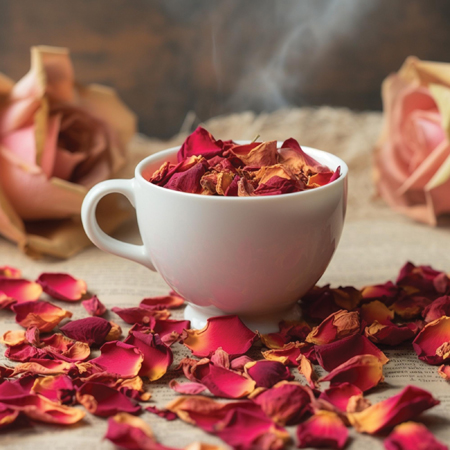
Rose Masala Chai
- 3/4 cup water
- 1/2 cup whole milk (or adjust if you’re not feeling whole-hearted)
- A 1-inch piece of ginger (sliced, diced, or karate- chopped—your call)
- 1-2 sticks of Ceylon cinnamon (or your favorite spice superstar)
- 1-2 tbsp lemongrass (for a zesty twist)
- 4-5 black peppercorns (for that extra kick)
- 1 tbsp of The Chai Bar’s Astitva – Brew Your Own Blend (or 2 tsp Astitva if you’re not going all-in with whole milk)
- 2 tsp of Rani rose sugar
Crush the spices like they owe you money (or use a spice grinder if you’re feeling fancy). Now grab a pot, toss in the spices, water, and milk, and let them get to know each other over a nice, hot boil. Add rose sugar and tea leaves and let the party simmer for an additional 4 minutes. Strain that delightful concoction and you’ve got a cup of rose masala chai ready to embrace your taste buds.
Remember, masala chai is all about personalization, so feel free to tweak, twirl, and tango with the ingredients. Just promise one thing—no masala chai dance-offs in the kitchen!
Monica Sunny
Founder, The Chai Box
Marietta-based human resource consultant-turned-entrepreneur, Monica Sunny founded The Chai Box in 2017 to bring the craft of traditional chai-making to everyone’s home with small-batch chai concentrate, robust loose-leaf chai blends, and premium single-origin spices. The Chai Box’s Ultimate Chai Lovers Gift Set was even included in Oprah’s Favorite Things in 2021.
My first distinct memory of chai is watching my retired police officer grandfather take his sweet time to drink and relax with an entire pot of tea every morning. But it was around the age of 12 that I really took an interest in tea and came up with my first blend which is the inspiration for one of The Chai Box’s first “True Blend”—a mix including Assam and Darjeeling teas.
One of my goals when starting The Chai Box was to introduce people to the flavors of India, as not all chai is equal. That is why I created over 14 blends inspired by different regions of India. For example, I grew up drinking chai with lots of ginger, fennel, and cardamom, so I created the blend “Punjaban Party” based on my mom’s recipe to showcase the flavors of this region. We really have “a chai for every mood!”
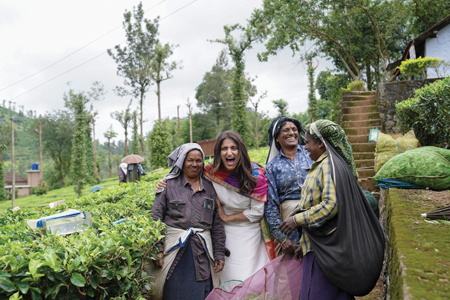
Every Friday after school, I had chai time with my three boys (then two, four, and five; now 18, 20, and 21). I wanted to make sure that my kids experienced the same ritual that I shared with my parents and that I passed along this important tradition. I modified a traditional masala dabba with tea leaves, spices, and sugar— what the boys referred to as “The Chai Box”—and taught them how to prepare the perfect cup of chai. This was our first signature product and continues to be a customer favorite because of the many ways you can customize your daily chai.
My son Ethan and I also created a chai concentrate that took 174 trials over one year to perfect the recipe that, he says, “tastes like home!” You can simply add milk and enjoy it on the go, hot or iced.
I think the best part of this job for me is my morning “Chai Meditations” on Instagram. Sharing how I make my cup of chai each day has allowed me to introduce people to the art and craft of traditional chai-making, key tools (i.e. stainless steel pots, mortar and pestle) needed, and their benefits while encouraging people to take time for themselves which is the true essence of our brand that is rooted in tradition.
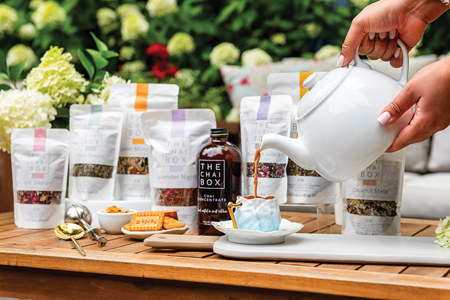
“One of my goals when starting The Chai Box was to introduce people to the flavors of India, as not all chai is equal. That is why I created over 14 blends inspired by different regions of India,” says Sunny. (Photo: Lauren Liz)
True Blend Chai
Here’s my perfect chai recipe (second to my dad’s) 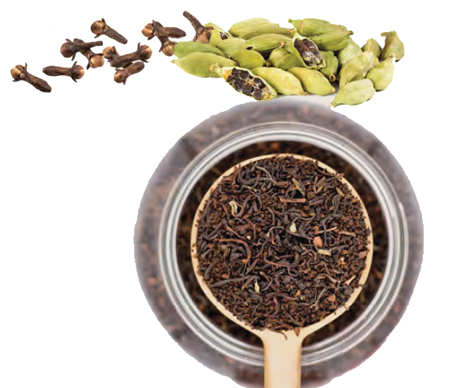
- 1 cup water
- 1 cup milk
- 3-4 tsp True Blend (loose-leaf tea blend)
- 4 cardamom pods (lightly crushed open)
- 2 cloves (lightly crushed)
- 3 small pieces of cinnamon (1/2 inch each)
- A pinch of fennel (8-10 fennel seeds)
- 1 tsp rose petals
- 1 tsp candied ginger
In a small saucepan, add water, cardamom, clove, cinnamon, fennel, rose petals, and candied ginger and bring to a boil. Once boiling, add in True Blend and simmer for 1-2 minutes. Add milk and bring it to a boil. Turn off the stove once the chai starts to bubble up. Use a strainer to strain ingredients when pouring chai into a teacup. Add honey or sugar if desired.
Esha Chhabra
Co-Founder, Alaya Tea
Environment, business, and agriculture writer and author of the book “Working to Restore,” Esha Chhabra founded Alaya Tea with her partner Smita Satiani. The Los Angeles-based women-owned loose-leaf organic tea company sources high-quality tea directly from organic and biodynamic estates in India. All their teas are sold in compostable, plastic-free packaging.
Smita and I had been friends for years and met up in 2017 to have drinks. It was during that meeting in San Francisco that we thought of starting a company together. We both had been working in the impact sector for nearly a decade and wanted to build something of our own. I had just returned from a journalistic trip to Darjeeling in India where I saw how the tea industry had been facing challenges due to climate change. So, we started talking about how we could make an eco-forward tea brand that specializes in high-quality tea sourced from organic, biodynamic, and regenerative estates.
By investing in soil health and the overall health of the estates, tea growers can mitigate some of the environmental risks. For example, heavy and erratic monsoons can lead to flooding and soil erosion. But the estates that have better soil health are able to absorb the water and reduce soil erosion. That’s just one example of how regenerative practices help tea estates.
We also work with a pottery studio on a permaculture farm in South India to source our mugs that drive impact. It’s incredible to see shipping containers turned into pottery studios and local communities training in pottery-making so they can have supplemental sources of income.
It is important to note that mass-produced brands are not only made with poor quality ingredients but are also unsustainable. Tea found in tea bags is “fanned” which means it is “reject” left after higher grades of teas have been gathered and is often pulverized into a fine powder devoid of flavor and nutritional profile. Some brands use artificial or unnatural flavorings to give their teas a fruity, spicy, or floral taste. Tea bags, even paper filters, create unnecessary waste and release microplastics when brewed in hot water. A 2019 study by McGill University found that steeping a single plastic teabag at brewing temperature releases approximately 11.6 billion microplastics and 3.1 billion nanoplastics that end up in water streams and pollute agricultural plots. Even the paper tea bags have some plastic in order to seal the bag. If you must dip, opt for tea bags made of compostable plastic-free and plant-based materials—some of which are offered by Pukka, Celestial Seasonings, and Dilmah.
Alaya Tea is an eco-forward tea brand that specializes in high-quality tea sourced from organic, biodynamic, and regenerative estates.
Cardamom Chai
Add a couple of crushed green cardamom pods in water and let it boil. Add in tea leaves. We like Assam Orthodox leaves for a lighter brew. Let it infuse (turn down the heat on the stove) for 3-5 minutes. Then add milk of choice and enjoy. This is a lighter, more delicate take on chai.
As someone who has spent more than half my life in the U.S., a fresh, spicy, and flavorful cup chai still remains my preferred drink when I am traveling and also while at home. Something about the rich robust flavor invokes my senses that coffee or herbal teas don’t. I often find myself ordering “chai tea” at coffee shops, only to be disappointed by the extremely sweet and syrupy drink. Spices like cinnamon are sprinkled on top as an afterthought and don’t blend in the liquid. I wish more baristas in the Western world took the time to brew tea properly in a pot of hot water rather than use instant mixes.
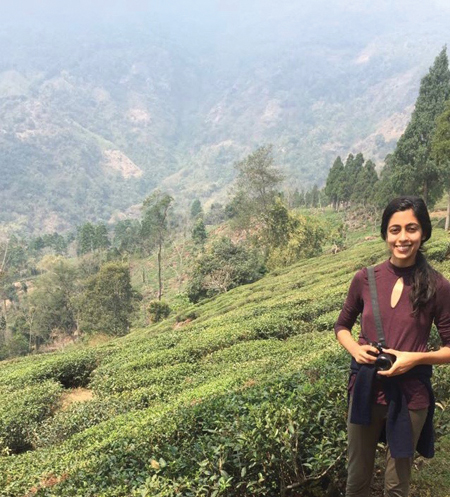
Brewing the perfect cup of chai is an art that requires practice and patience. When I want a good cup of tea or am entertaining guests, I have a variety of small-batch brands such as the ones mentioned earlier. I simmer the fresh tea leaves on medium heat in hot water and add a few cardamom pods and a piece of ginger root for an extra kick. Depending on the mood, I may add a pinch of tea masala (Spicewalla is generally on my kitchen shelf), a generous amount of almond milk, and a little bit of raw brown sugar. It takes almost half an hour to get the strength I like, but it is well worth the wait.
However, I am on the road a lot, and to me, a chai that tastes like at home is still not as readily available as one might think. So, I pack a few pouches of Wagh Bakri masala chai powder, the popular Gujarati brand, in my carry-on bag for those “emergency” situations when I am traveling in another part of the world and just need a little flavor of home. The single-serve pouches have spices and milk powder mixed in and hot water is easily available at airports and hotel rooms. Chai invokes different feelings in different people. There’s no right time of the day to drink it, no one recipe, or one single way to brew it. Its flavor profile may have changed over time, its authenticity may be diluted, but the passion for it only grows over time. The next time you sip on a cup of chai, think about all the people and events that helped enable the experience!
~ Written for and published by Khabar Magazine. All rights reserved.